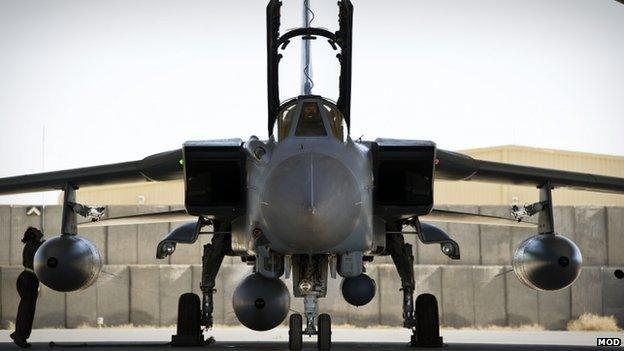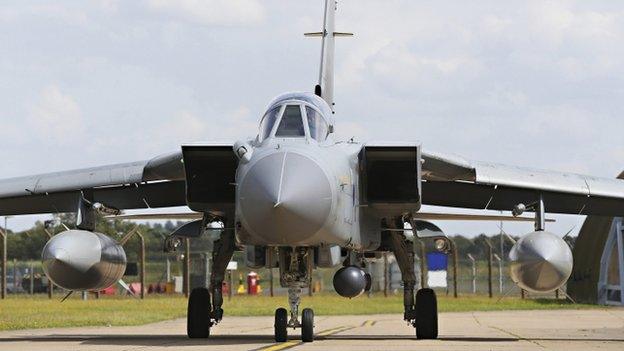RAF fighter plane numbers to reach 'all-time low'
- Published

The number of RAF fighter planes is set to fall to the lowest in its history, defence experts have warned.
Defence analysis group IHS Jane's, external said the RAF could be left with 127 combat jets by the end of the decade as 87 Tornados and the first tranche of 53 Typhoon jets are due to be retired.
It would leave the RAF with its fewest number of fighter planes since 1918.
The Ministry of Defence said the RAF "has and will have" the aircraft it needs to meet its global commitments.
The government also says it is increasing the defence budget and will replace the older Tornados with the F-35B.
It has only bought eight of these so far and the aircraft are not due to be at "full operating capability" until 2023.
Defence chiefs have already warned the RAF is stretched and the analysis says that further loss of UK airpower would seem "perverse".
Chief of the Defence Staff General Sir Nicholas Houghton last week described the RAF as at the "very limits of its fast jet availability".

The F-35B is replacing the RAF's Tornado fighter fleet
Defence spending
Jane's says the RAF currently has 192 frontline fighter aircraft, made up of Tranche 1, 2 and 3A Typhoons and Tornados.
While all 40 Tranche 3A Typhoons should be with the RAF by 2019, and will remain in service, only about 15 to 20 F-35Bs are expected to have been delivered by this time.
Jane's also says there is "no physical reason why the existing 53 Tranche 1 Typhoons could not be retained in service out to 2030" with a "rolling programme of upgrades to their systems".
An MoD spokeswoman said the RAF would remain capable of carrying out operations around the world.
These include Tornado air strikes against so-called Islamic State in Iraq, providing surveillance over Syria with Reaper flights, or patrolling the skies over the UK and in the Falkland Islands with Typhoon jets.
She added: "Tough decisions were made during the last Strategic Defence and Security Review to rationalise our fast jet forces into two advanced and efficient fleets and we continue to assess future requirements ahead of this year's SDSR, which is supported by our £160bn equipment programme that will deliver the fifth-generation Lightning II joint strike fighter."
Earlier this month, Chancellor George Osborne pledged to meet Nato's target of spending 2% of national income on defence every year, up to 2020.
He also announced that spending on defence was to rise in real terms - 0.5% above inflation - every year during the Parliament.
- Published13 July 2015

- Published8 July 2015

- Published25 June 2015
